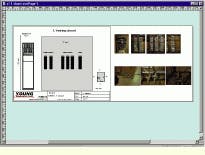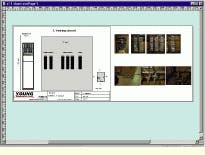Cabling contractors can find a silver lining in the Y2K cloud.
Steve Vallejos
IMAP Corp.
Over the last year, we have heard a lot about concerns for the year 2000 and its effect on the communications systems and software that businesses use today. By now, most organizations have decided whether they need to address this potential problem.
As a cabling contractor, you may already have benefited from additional Y2K-related work as some of your clients upgrade their cabling systems and connectivity devices. This kind of job is probably all you can expect from small and medium-sized customer organizations.
But larger organizations such as hospitals, universities, financial institutions, retail chains, manufacturing plants, and a host of others view the issue of year 2000 compliance more seriously. It turns out that many of these organizations still require the processing power of a mainframe for their existence and have built their modern systems around such a host.
As we near the millennium, there is a frantic rush to evaluate the host and its connected systems to determine if they are in compliance with the roll-over date of December 31, 1999 at 11:59 PM and 59 seconds. Will the systems roll over to January 1, 2000 or to January 1, 1900? This concern earned one contracting company (a national integration firm) the task of evaluating all communications systems for a 650-hospital chain around the nation.
So how does this relate to cabling contractors, designers, and installers like yourself? The answer is as simple as the reason why the Y2K audits are taking place: physical layer documentation.
That`s right. The only reason companies and institutions are paying someone else to evaluate their system is because they didn`t have the information documented in the first place. Now don`t go scold your clients just yet. Besides, there is no money to be made for saying, "I told you so."
There is, however, an opportunity to help your customer prolong the life of this precious information that is being gathered with a connectivity-management software package. Why not? Most companies have been waiting for the excuse to deploy connectivity- or cable-management software but have not found the way to cost-justify such a move or allocate resources to get started. In fact, with Y2K looming, this might be the ideal time to suggest that your clients invest in such software, since the financial impact of an audit is still fresh in their minds.
So, now that you look like a saint to your customers by protecting their interests, let`s talk about how this suggestion can accomplish two goals for you: generating a new revenue stream, and securing your relationship with your clients.
The firms that audit telecommunications systems are typically not construction-minded people because they may only provide the client with a spreadsheet with the information requested, without floor plans identifying infrastructure placement or connection information. Most customers, not knowing they need this information on the front end, will accept a contract that omits drawings and connection information, only to find out after the audit is completed that these elements are critical to assess the physical changes required as the project progresses. This may be your first opportunity to get involved with the project, by tracing the circuits and marking the locations on a print.
Your next chance to generate revenue requires that you provide a cable-management tool and populate it with the information that was gathered. Before you break out in hives imagining the process, you should know that the cable-management software industry has come a long way in the past couple of years. There are products on the market that cater to everything from a simple circuit trace builder to applications that are fully customizable for the largest of companies. Your goal is to identify a program that is easy to use and generates affordable drawings in a format with which you and your customer are familiar. Several products, including ours, have partner programs designed to help contractors take advantage of this technology.
If you`re not comfortable trying to sell the concept to your customers alone, some companies offer demonstration CDs or go out on the call with you to demonstrate the product. Let them help--they want the business just as much as you do.
Adding value
Getting involved with a Y2K project for the purpose of creating documentation and specifying connectivity management adds value to your current service offerings. This value-added service may be the edge you need to fight off those nasty competitors that circle your business like vultures, waiting for the right time to overthrow you with price-reduction tactics and fairy tales of better service. If you create and maintain the connection documentation as a part of your service to your clients, you`ll keep them from shopping around. After all, the idea of saving a couple of bucks by returning to an undocumented solution will lose a lot of its appeal.
So how do you get this project going? Here are a few tips:
Don`t oversell the product and all its features at the front end. Instead, show your customers how they will house the information they already have. Sometime after the project is completed, customers will find a feature within the application that they didn`t know about and will want to take advantage of it. Look at this as future revenue potential.
If your client is using one of the auto-discovery tools, such as Visio`s new Enterprise product to search for personal computers on the network, this information can be passed on to the cable-management software as well. This information can significantly reduce and even eliminate some of the physical audit requirements. Talk to your cable-management software representative to determine how this will save your client time and money.
Cable-management software can also serve as a crucial part of the Y2K upgrade process. The fact-finding mission will be several months to a year away from the change or upgrade schedule, and the resources that perform the work may be different. These variables are an excellent reason alone to use a cable-management tool.
Now is the time to get off the sidelines and get involved. Remember, after 2000 the next opportunity is Y3K.
Steve Vallejos is president of imap Corp. (Walnut Creek, CA), which makes visual cable-management software. For more information, visit www.ycinc.com.

